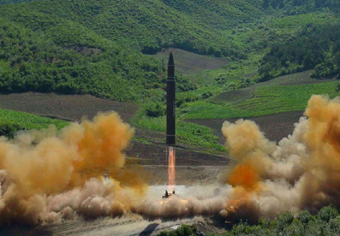
Image North Korea state media
North Korea Tests Two-Stage ICBM
| published July 4, 2017 |
By Thursday Review staff writers
North Korea test fired a missile off its east coast and into the Sea of Japan early on Tuesday, according to the Japanese government, the South Korean military, and the Pentagon. News of the launch came by way of the Joint Chiefs of Staff for South Korea, and has been confirmed by sources within the Pentagon.
The missile was of an unknown, possibly new type, but has been identified as a “probable ICBM” by Pentagon analysts and other weapons experts who have studied new video footage of the early morning launch. The missile was fired from a launch facility north of Pyongyang, and may have included a two-stage ascent. Military analysts in Japan and South Korea say that the flight of the missile included a second-stage booster produced at least 30 more seconds of propulsion.
According to analysts in both Japan and South Korea, the missile impacted at sea roughly 160 miles from the west coast of Japan, or well within that country’s Exclusive Economic Zone, which extends 200 miles from land. All told, the rocket travelled nearly 600 miles before its splashdown in the sea. Some American weapons analysts have said that the missile tested on Tuesday could very well have the range and capability to reach the western coast of Alaska, making this new North Korean rocket the country’s most potentially dangerous.
The launch prompted the White House to conduct a series of high level meetings on Tuesday to analyze the video, assess other intelligence data regarding the launch, and consider options, including possible military responses. U.S., British and Japanese intelligence agencies are closely reviewing satellite imagery and other tracking data to more fully understand the potential of this latest rocket test.
U.S. Secretary of State Rex Tillerson called for the U.S. and its allies to engage in stronger action to force North Korea to abandon its nuclear aspirations. Tillerson described Tuesday’s launch as provocative and “a new escalation of the threats to the United States, our allies and partners, the region, and the world.”
Tuesday’s missile test is the latest in a long series of rocket and missile launches by North Korea—more than a dozen successful this year—and yet another step in a rapidly escalating international crisis involving the rogue nation and its neighbors, as well as the United States. Helmed by the young dictator Kim Jong-un, North Korea has ramped up both its missile program and its overt ambitions to become a nuclear power. Kim’s stated goal: the ability to launch nuclear tipped rockets at the U.S. and it allies.
North Korea has tested at least six nuclear devices in the last four years. But over the last 12 months the country has been engaged in quickened program of missile development and testing. Though experts believe that Pyongyang falls short of the critical ability to miniaturize a nuclear warhead for installation on an intercontinental ballistic missile, many of those same weapons experts worry that North Korea could be less than two years away from that very goal—the placement of a small, lightweight nuclear device atop an ICBM.
But North Korean state media said that today’s launch was of a new ICBM already fully developed and prepared to carry a nuclear warhead, and Pyongyang television said that the country will be ready to place a nuclear device atop the larger, two-stage missile within months.
Though the missile, for test purposes, was launched on a particularly steep vertical trajectory—taking it some 1,740 miles above the Earth—such a rocket fired at a lower controlled trajectory could easily travel thousands of miles.
In response to the North Korean launch, military and intelligence components of South Korea and the United States engaged in a wide array of joint exercises and preparedness tests, including wargames designed to analyze stresses and responses by military and political leadership south of the DMZ, and as far away as American military bases in the Philippines and Hawaii. Military units in South Korea also tested the rapid use of missile defense systems designed to help protect military and civilian targets from incoming missiles. In addition, later in the day, the U.S. and South Korea fired missiles into the sea from coastal areas.
President Donald Trump, reacting early on Tuesday to news of the North Korean launch, again broadly indicated that a nuclear-armed North Korea would be a destabilizing factor in Asia, and would pose a real threat to South Korea and Japan. Trump also urged China to use its substantial leverage to discourage North Korea from further escalations.
North Korea has operated under heavy United Nations sanctions and restrictions for years, but members of the Kim dynasty—recently Kim Jong-un—have largely attempted to ignore or bypass such economic pressure. In late May, North Korea tested a new, more advanced guidance system.
The White House says that all options remain on the table, but some observers suggest that direct military action—while being carefully vetted and considered—would be fraught with risks, not the least of which would be a full-scale war on the Korean Peninsula and heavy loss of life, especially in Seoul, the capital of South Korea.
Though several recent missile tests by North Korea have failed, several have succeeded—an indication that the program is moving forward and that its designers and engineers are learning from mistakes. At least two of the tests may have failed due in part to cyber-intervention on the part of the U.S., though that has not been confirmed by American officials.
Related Thursday Review articles:
North Korea Tests New Guidance System; Keith H. Roberts; Thursday Review; May 30, 2017.
North Korea Missile May be New Type of Rocket; Keith H. Roberts; Thursday Review; May 14, 2017.
